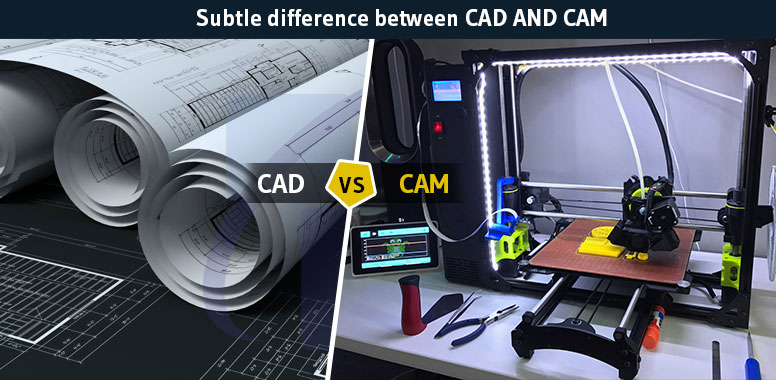Subtle difference between CAD and CAM

Overview
Computer Aided Drafting and Computer Aided Manufacturing are both technologies used for product designing and manufacturing purposes by the designers or drafters through designing software.
CAD Service Providers generates accurate and scaled models on the users input. An individual CAD model is coherence as components of an assembly to create a final product that fixes parts that can be verified. 3D model using AutoCAD software can be built for the design of components and its fixtures. Before constructing a building or structure, the model can be viewed from any angle virtually.
CAM is a manufacturing tool worked by computers that carries a lot of processes automatically such as cutting, turning, milling, routing and printing of solid materials. Once the design and analysis part of the product is manufactured through computers to check the product is made and by which process and how much time it took.
Difference between CAD and CAM
CAD is used to transform the idea of product into detailed engineering design. It aids in creating product’s geometric model that can be manipulated, analyzed and refined. CAM is used for automating production tasks and controls machine and systems by the manufacturing team.
CAD includes the process of defining the 3D model, translating the definition, interface and documentation. CAM includes processes of geometric modeling, numerical control programs, inspection and packaging.
CAD requires design concepts and analysis of product whereas CAM requires control and coordination of physical process, material and labor.
Advantages of CAD and CAM
CAD
It reduces the cost of hiring draftsmen for designing a product and directly generates cutting data for CNC machines. Scaling and re-scaling modification in drawings are easier and accurate. It accommodates storage and rectifies models easily. 3D Model can be examined before producing products from materials. It increases the speed of production and requires less labor as the machine performs all the work of a human.
CAM
It requires less labor intensive and saves labor cost as it can perform work electronically which requires minimum supervision. Machines are accurate, and the process is repeated automatically with large quantities. The occurrence of errors is less here, and it can run continually. A virtual machine can help in evaluating the outcomes and routines effectively.
Disadvantages of CAD and CAM
CAD
Being computerized systems it can cause the problem of viruses and power cut can stop work in the middle. An industrial version of the software is expensive. The traditional method is lost, and accuracy is machine-driven. The training cost is more for learning the software.
CAM
It needs a huge investment in software, maintenance cost and start-up cost is more. Fewer workforces with high-level manual skills are required in carrying out the manufacturing process of design. Highly trained professionals are required for setting-up procedures and tooling.
Conclusion
CAD and CAM are connected terms that are used where the computers are involved in the design and manufacturing process of a product. These are technologies that have their pros and cons and require in-depth analysis of different processes that they possess. CAD helps in the design process of a product that is accurate and precise. CAM is the manufacturing process of a product that speeds productivity and less labor cost is incurred.

